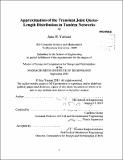Approximation of the transient joint queue-length distribution in tandem networks
Author(s)
Yamani, Jana H. (Jana Hashim)
DownloadFull printable version (6.532Mb)
Other Contributors
Massachusetts Institute of Technology. Computation for Design and Optimization Program.
Advisor
Carolina Osorio.
Terms of use
Metadata
Show full item recordAbstract
This work considers an urban traffic network, and represents it as a Markovian queueing network. This work proposes an analytical approximation of the time-dependent joint queue-length distribution of the network. The challenge is to provide an accurate analytical description of between and within queue (i.e. link) dynamics, while deriving a tractable approach. In order to achieve this, we use an aggregate description of queue states (i.e. state space reduction). These are referred to as aggregate (queue-length) distributions. This reduces the dimensionality of the joint distribution. The proposed method is formulated over three different stages: we approximate the time-dependent aggregate distribution of 1) a single queue, 2) a tandem 3-queue network, 3) a tandem network of arbitrary size. The third stage decomposes the network into overlapping 3-queue sub-networks. The methods are validated versus simulation results. We then use the proposed tandem network model to solve an urban traffic signal control problem, and analyze the added value of accounting for time-dependent between queue dependency in traffic management problems for congested urban networks.
Description
Thesis: S.M., Massachusetts Institute of Technology, Computation for Design and Optimization Program, 2013. Cataloged from PDF version of thesis. Includes bibliographical references (pages 95-97).
Date issued
2013Department
Massachusetts Institute of Technology. Computation for Design and Optimization ProgramPublisher
Massachusetts Institute of Technology
Keywords
Computation for Design and Optimization Program.